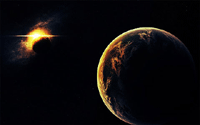 The longest total solar eclipse of the 21st century will take place on July 22. From almost everywhere in
The longest total solar eclipse of the 21st century will take place on July 22. From almost everywhere in
The longest total solar eclipse of the 21st century will take place on July 22. From almost everywhere in
The Vietnam Astronomy and Space Association’s Nguyen Duc Phuong said that the total eclipse will be witnessed within a 258km-wide strip running nearly half-way around the globe.
The phenomenon will first be observed in
The best location for observing the phenomenon in
The best site to observe the phenomenon in the world is in the Pacific Ocean, with the maximum time of 6.39 minutes, at 9.35am,
Phuong said that there are 2-5 solar eclipses a year but a total eclipse is rare. Some years don’t see total eclipses but some have as many as two. Total eclipses often take place within a very short time, rarely exceeding 7.31 minutes. There are only around 10 total eclipses of over 7 minutes every 1,000 years. The latest eclipse of 7.3 minutes was recorded on June 30, 1973.
|
A solar eclipse occurs when the moon passes between the Sun and the Earth so that the Sun is fully or partially obscured. This can only happen during a new moon, when the Sun and Moon are in conjunction as seen from the Earth. At least two and up to five solar eclipses can occur each year on Earth, with between zero and two of them being total eclipses. A total eclipse occurs when the Sun is completely obscured by the Moon. The intensely bright disk of the Sun is replaced by the dark silhouette of the Moon, and the much fainter corona is visible. During any one eclipse, totality is visible only from at most a narrow track on the surface of the Earth. Total solar eclipses are nevertheless rare at any location because during each eclipse totality exists only along a narrow corridor in the relatively tiny area of the Moon' + char(39)+ N's umbra. A total solar eclipse is a spectacular natural phenomenon and many people travel to remote locations to observe one. The 1999 total eclipse in In ancient times, and in some cultures today, solar eclipses have been attributed to supernatural causes. Total solar eclipses can be frightening for people who are unaware of their astronomical explanation, as the Sun seems to disappear in the middle of the day and the sky darkens in a matter of minutes. |

 Previous page
Previous page Back to top
Back to top







